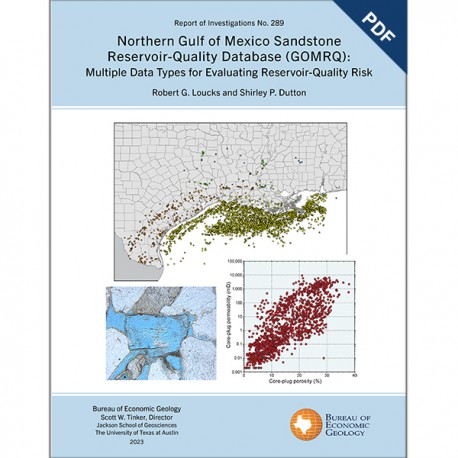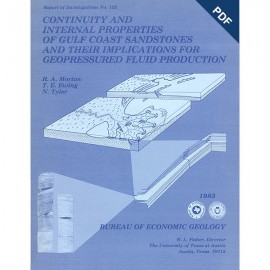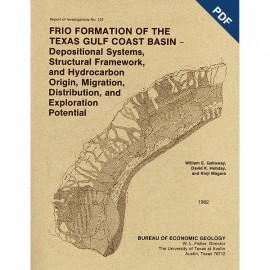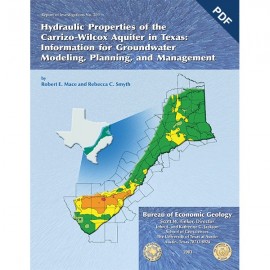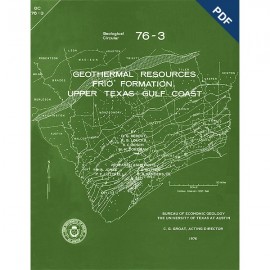Reports of Investigations
-
Books & Reports
- Reports of Investigations
- Guidebooks
- Udden Series
- Geological Circulars
- Down To Earth
- Atlases of Major Oil and Gas Reservoirs
- Texas Memorial Museum Publications
- Environmental Geologic Atlas of the Texas Coastal Zone
- Mineral Resource Circulars
- Other Reports
- Seminars and Workshops
- Handbooks
- Submerged Lands of Texas
- Symposia
- Annual Reports
- Open File Reports
-
Maps & Cross Sections
- Thematic Maps
- Miscellaneous Maps, Charts & Sections
- Geologic Atlas of Texas
- STATEMAP Project Maps
- Geologic Quadrangle Maps
- Cross Sections
- Highway Geology Map
- Energy and Mineral Resource Maps
- Shoreline Change and Other Posters
- Wilcox Group, East Texas, Geological / Hydrological Folios
- Bouguer Gravity Atlas of Texas
- River Basin Regional Studies
- Featured Maps
- Posters
- Teachers & the Public
-
Geological Society Publications
- Gulf Coast Association of Geological Societies
- Alabama Geological Society
- Austin Geological Society
- Corpus Christi Geological Society
- Houston Geological Society
- Lafayette Geological Society
- Mississippi Geological Society
- New Orleans Geological Society
- South Texas Geological Society
- GCS SEPM Publications
- Historic BEG & UT Series
Northern Gulf of Mexico Sandstone Reservoir-Quality Database (GOMRQ)
RI0289D
Northern Gulf of Mexico Sandstone Reservoir-Quality Database (GOMRQ): Multiple Data Types for Evaluating Reservoir-Quality Risk by Robert G. Loucks and Shirley P. Dutton. 2023
16 page PDF report with Microsoft Excel and PowerPoint data set. Digital download.
doi.org/10.23867/RI0289D
This unique dataset contains years’ worth of data collection and careful analysis, much of which would be near impossible to replicate since formerly public files are no longer available and the core sampling would not be allowed. Reservoir quality, affected by many geologic factors, is a critical component in forecasting economical reservoirs in sandstones. The assembly of this large reservoir-quality database allows the data to be integrated into analytical programs to improve the quality of the forecast.
The dataset is comprised of statistical reservoir-quality data and petrographic thin-section point-count analyses for the northern Gulf of Mexico sandstones ranging in age from Jurassic (Norphlet Formation) to Pleistocene, including:
- Core-based porosity and permeability data (30,207 analyses from 646 wells)
- Wireline analysis of porosity from 53 wells
- Modified MMS Gulf Coast pool database (12,658 pools)
- Thirty mercury injection capillary pressure analyses
- Thin-section point-count analysis with associated porosity and permeability analyses (889 thin sections from 148 wells)
The data can be imported easily into other programs from the included Excel spreadsheets.
About the Authors:
Robert (Bob) G. Loucks has more than 30 years of research, reservoir characterization, and exploration experience with Texaco, the Bureau of Economic Geology, Cities Service, and the ARCO Technology Center, where he worked for 17 years. His research interests include carbonate, siliciclastic, and mudstone sequence stratigraphy, depositional systems, diagenesis, and reservoir characterization. Bob has worked in Texas, Alaska, California, the Gulf Coast, the Middle East, North Africa, and East Asia.
Shirley P. Dutton retired from the Bureau of Economic Geology as a senior research scientist with more than 40 years of experience. She has been predominantly involved in research on the sedimentology and diagenesis of hydrocarbon reservoirs. Her expertise includes sandstone petrography and diagenesis, the relationship of reservoir properties to diagenesis, and the interpretation of depositional and diagenetic history of turbidite sandstones. She earned a B.A. in geology from the University of Rochester and M.A. and Ph.D. degrees in geological sciences from The University of Texas at Austin.
Abstract:
Reservoir quality (i.e., porosity and permeability) is a major risk factor in forecasting economical reservoirs in sandstones. Many geologic factors affect reservoir quality, which makes forecasting difficult. However, construction of statistical and petrographic databases that collect a large population of reservoir quality data under known conditions greatly aids a worker in producing a forecast. Such databases provide a realistic range of reservoir-quality values that can be expected under designated conditions, which constrains the forecast.
Two types of reservoir-quality data sets have been constructed for the northern Gulf of Mexico sandstones ranging in age from Jurassic (Norphlet Formation) to Pleistocene. One data set is a collection of statistical reservoir-quality data, such as core porosity and permeability analyses, wireline-log porosity analyses, pool-data summary statistics, and mercury injection capillary pressure. The other data set consists of petrographic thin-section point-count analyses with associated porosity and permeability measurements. The assembly of these large reservoir quality databases into Microsoft Excel digital spreadsheets allows the data to be integrated into analytical programs to forecast reservoir quality.
